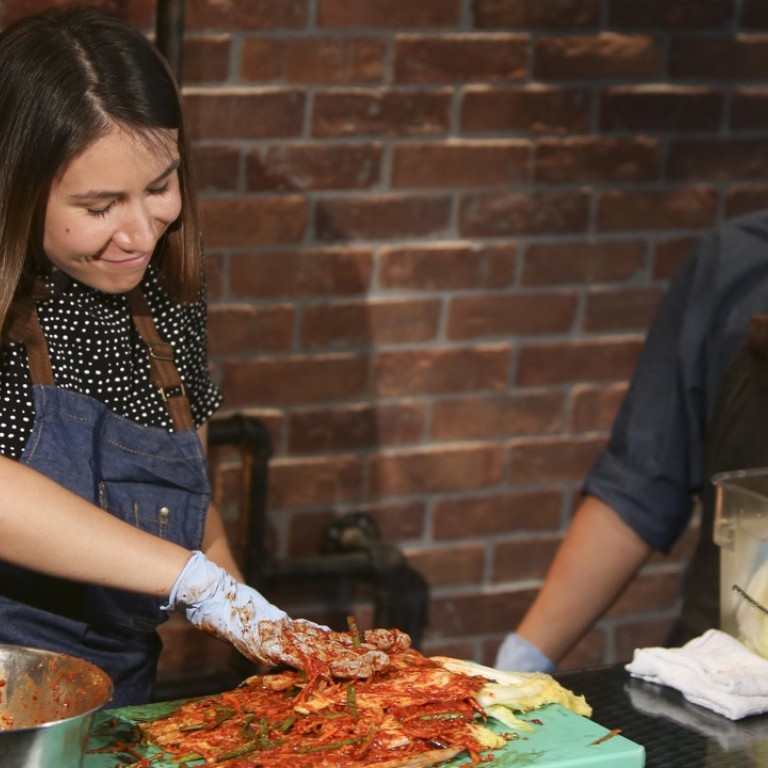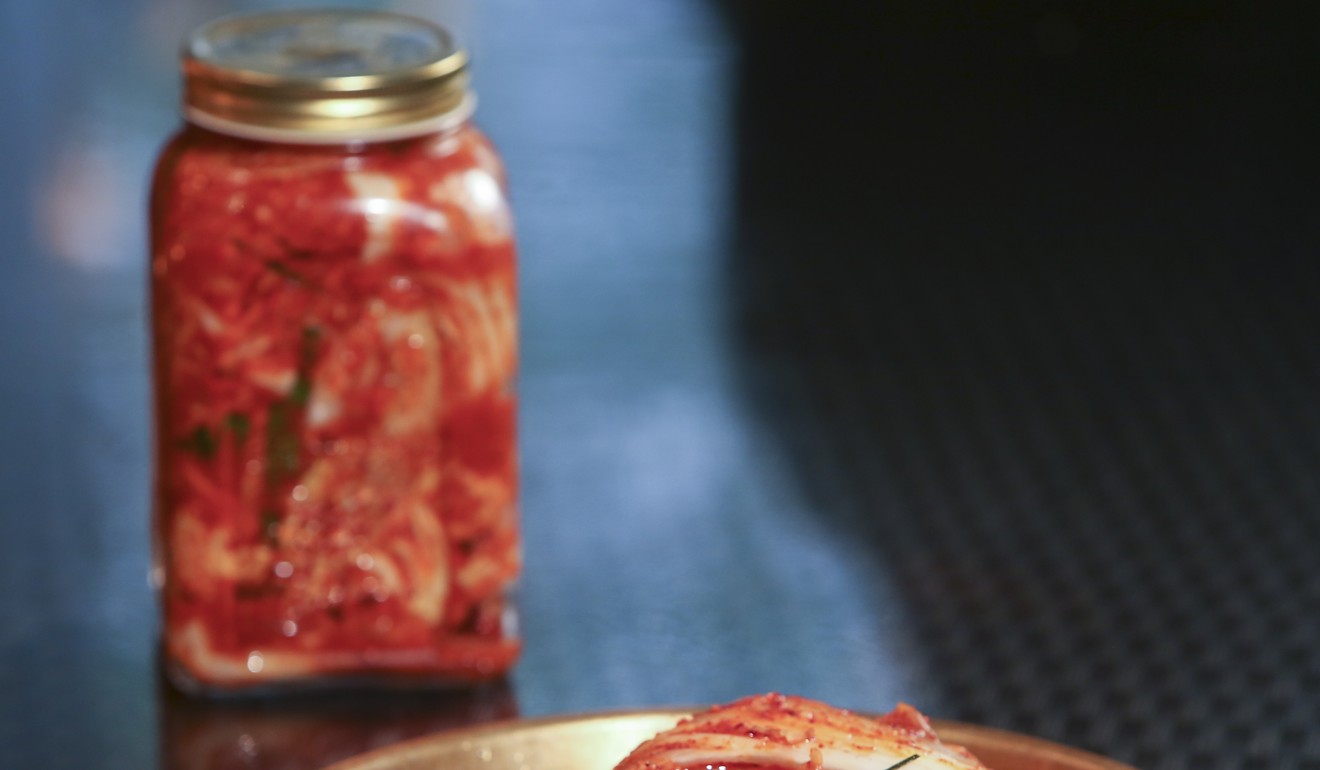
Video | Kimchi: a Hong Kong Korean chef’s easy video recipe for the spicy-sour staple
No matter how tiny your kitchen, you can make kimchi at home. Just follow the recipe from Bib n Hops’ head chef Yong Soo Do, who learned to make the fermented vegetable dish from his mother while growing up in Canada
Watching chef Yong Soo-do dance as he puts the finishing touches to a fresh batch of kimchi, it’s obvious he has a serious affection for the fermented vegetables.
In North Korea, even the production of kimchi can be revolutionised by technological know-how
Kimchi, a staple in Korean cuisine, is made with salted vegetables (the most popular is cabbage). Although there are mild, unspicy “white” kimchis, most people think of the pungent, spicy and sour kimchi made with gochugaru (Korean chilli flakes) and (often) fish sauce.
Kimchi began as a way to preserve vegetables to help families make it through the long, harsh Korean winters. Initially it was made without spice, much like sauerkraut, and stored underground in jars to keep it cool, but unfrozen. The recipe evolved over time, and was adapted to meet the needs of different regions; many families have their own recipe for kimchi.
“Food … carries the history of a region and its culture,” says Yong, who comes from a family of chefs and was born in Busan on the southeast coast of Korea and raised in Toronto. “If you go to the north side of Korea, the kimchi is a little less spicy; if you go south, where it is colder, it is heavier and spicier; and if you go to the east coast, they will put oysters in it. We are using salted shrimps, but you could use salted squid and salted mussels.
At Bib n Hops we make kimchi with choi sum … I mean, we are in Hong Kong, why don’t we make kimchi with Hong Kong vegetables?
“It’s very farm-to-table food. Basically whatever you can get in your region you can put in it. That’s why kimchi is so interesting; even if you go to a different city, the style of the kimchi changes and the flavour changes.”
For instance, now that he is in Hong Kong, Yong has changed his family’s recipe. “At Bib n Hops we make kimchi with choi sum,” he says. “I wanted to experiment. I’ve used bok choi and gau choi; any Chinese vegetable you see in the market. I mean, we are in Hong Kong, why don’t we make kimchi with Hong Kong vegetables?”
There are a number of health benefits associated with eating the high-fibre, nutrient-packed dish. The probiotics associated with the fermentation process promote healthy digestion. It’s also believed that kimchi helps regulate cholesterol levels and, being packed with ginger, garlic and chilli, it’s said to support a healthy immune system. Yong, a youthful-looking 30, swears the dish is an anti-ageing treatment too.

Bib n Hops now runs kimchi-making classes at its Quarry Bay branch. While it takes time, you can have fun while you’re at it, says Yong – and he is adamant you can make it at home too, even if you have a tiny kitchen. Just be sure to lay a few plastic bags or paper sheets on the table or floor before you start; it is going to get messy – that’s not a warning, it’s a guarantee.
Susan Jung shares her kimchi recipe
Yong shared with us his personal kimchi recipe, adapted from his mum’s.
Cabbage brine ingredients:
Two napa cabbages
4 litres of water
200g salt
40g sugar
Put the water, salt and sugar in a large bowl and mix until they dissolve.
Cut the cabbages in half lengthwise. Make a slit at the base of the cabbage to ensure the salt can penetrate easily.
Briefly soak the cabbages in the salt brine, then place them in a large plastic container with the cut side facing upwards.
Spreading the leaves apart with your hands, sprinkle a large pinch of salt between each layer of the cabbage.
Pour the salt brine into the container. Put a clean weight on top of the cabbages to make sure they are submerged in the brine, and place the container away from sunlight.
After leaving to brine for 24 hours, thoroughly rinse the cabbage halves, squeezing out the excess water. The cabbage should now look slightly transparent and feel soft and limp. Reserve some of the brine liquid.

Kimchi paste ingredients:
500ml water
60g rice flour
About 180ml brine liquid
130g coarse gochugaru (Korean chilli flakes)
90g Korean salted shrimps (this is sold in jars at shops specialising in Korean ingredients)
130g minced garlic
26g minced ginger
55ml fish sauce
8 grams sugar
70 grams chives, cut into 5cm pieces
70 grams julienned carrots
200 grams julienned daikon
Salt (as needed)
Bring the water to the boil in a pot, then turn it down to a simmer.
Pour rice flour into the pot and whisk. Stir over a low flame for about 15 minutes, or until the mixture becomes thick, then remove from the heat. Cool to room temperature before mixing in the gochugaru.
Add the salted shrimps, garlic, ginger, fish sauce and sugar and mix well. Mix in some of the brine liquid to bring it to a spreadable paste consistency.
Add all remaining ingredients and mix.

It’s a good idea to put on kitchen gloves for the next steps.
Lay the cabbage halves on a board and rub a thin layer of the spice paste onto each cabbage leaf. Be sure to completely cover each section of the cabbage in a thin layer of the paste.
Pack the kimchi into a large glass jar and seal the lid, making sure it is airtight. WARNING: do not fill the jar completely, so the juices don’t bubble up and seep out during the fermentation process (as they did for me!).
Store for at least five days before eating.
How fermentation is making Hong Kong restaurant dishes more flavourful and healthy

